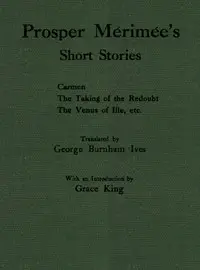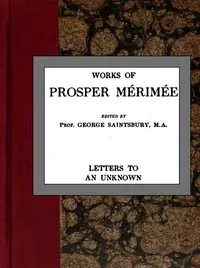"The Abbé Aubain and Mosaics" by Prosper Mérimée is a compilation of short stories set in the 1800's, including the story of Abbé Aubain, a priest dealing with inner conflict, and other narratives such as "Mateo Falcone," which examine duty, love, and right and wrong choices. The book is made up of scholarly accuracy and emotional complexity, and paints a picture of the intricate human condition and the rules of society. "The Abbé Aubain" begins with letters from Madame de P-----, who talks about her life in Noirmoutiers and her conversations with Abbé Aubain. Madame shows her unhappiness with her life, confessing resignation to money problems and touching on feelings of loneliness and soul-searching. Her letters show her complicated relationship with her husband and her growing feelings for the Abbé, implying humor, despair, and maybe secret feelings. The story sets the stage for looking into themes of love, loss, and humans' need for connection.

Abbé Aubain and Mosaics
By Prosper Mérimée
Through intertwined lives and emotional revelations, a priest and a woman grapple with longing, duty, and the constraints of society in 19th-century France.
Summary
About the AuthorProsper Mérimée was a French writer in the movement of Romanticism, one of the pioneers of the novella, a short novel or long short story. He was also a noted archaeologist and historian, an important figure in the history of architectural preservation. He is best known for his novella Carmen, which became the basis of Bizet's opera Carmen. He learned Russian, a language for which he had great affection, before translating the work of several notable Russian writers, including Pushkin and Gogol, into French. From 1830 until 1860 he was the inspector of French historical monuments, responsible for the protection of many historic sites, including the medieval citadel of Carcassonne and the restoration of the façade of the cathedral of Notre-Dame de Paris. Along with the writer George Sand, he discovered the series of tapestries called The Lady and the Unicorn, arranging for their preservation. He was instrumental in the creation of Musée national du Moyen Âge in Paris, where the tapestries now are displayed. The official database of French monuments, the Base Mérimée, bears his name.
Prosper Mérimée was a French writer in the movement of Romanticism, one of the pioneers of the novella, a short novel or long short story. He was also a noted archaeologist and historian, an important figure in the history of architectural preservation. He is best known for his novella Carmen, which became the basis of Bizet's opera Carmen. He learned Russian, a language for which he had great affection, before translating the work of several notable Russian writers, including Pushkin and Gogol, into French. From 1830 until 1860 he was the inspector of French historical monuments, responsible for the protection of many historic sites, including the medieval citadel of Carcassonne and the restoration of the façade of the cathedral of Notre-Dame de Paris. Along with the writer George Sand, he discovered the series of tapestries called The Lady and the Unicorn, arranging for their preservation. He was instrumental in the creation of Musée national du Moyen Âge in Paris, where the tapestries now are displayed. The official database of French monuments, the Base Mérimée, bears his name.











